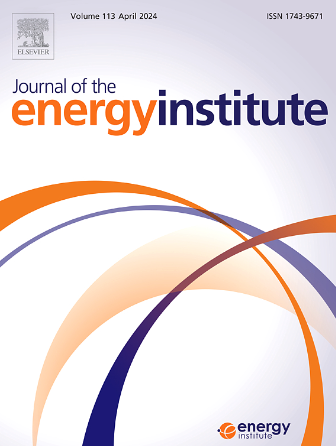通过直接甲烷化和焦油催化裂化,促进生物质气化生产富含甲烷的生物燃料
IF 5.6
2区 工程技术
Q2 ENERGY & FUELS
引用次数: 0
摘要
从生物质合成气中生产甲烷通常是水密集型的,因为需要通过水气转换反应增加H/C比。其中,上游稻壳气化后,下游直接甲烷化利用低H/C比的合成气生产富甲烷生物燃料,无需事先进行水气转换反应,节约成本。在上游耦合焦油裂化反应,调整H/C比和汽焦油含量后,直接甲烷化的性能显著提高。当生物质与焦油裂化催化剂的比例为1:1时,CO转化率和CH4增长率分别由61.4%提高到110.7% - 94%和139.2%。表征结果表明,焦油裂解催化剂的加入也减少了下游非晶焦的形成,从而提高了甲烷化催化剂的稳定性。研究结果表明,将焦油催化裂化与合成气直接甲烷化相结合是提高合成气质量的有效途径。本文章由计算机程序翻译,如有差异,请以英文原文为准。
Promoting methane-rich biofuels production from gasification of biomass through direct methanation coupled with catalytic cracking of tar
Production of methane from biomass syngas is generally water-intensive due to the need to increase the H/C ratio through the water-gas shift reaction. Herein, after gasification of rice husk upstream, the syngas with low H/C ratio was utilized through direct methanation downstream to produce methane-rich biofuel without prior water-gas shift reaction for cost saving. After coupling the tar cracking reaction upstream to adjust the H/C ratio and the content of steam and tar, the performance of direct methanation was significantly enhanced. The CO conversion rate and CH4 growth rate increased from 61.4 % to 110.7 %–94 % and 139.2 %, respectively, when the ratio of biomass to tar cracking catalyst was set at 1:1. Characterization results revealed that the addition of the tar cracking catalyst also reduced the formation of amorphous coke downstream, thereby improving the stability of the methanation catalyst. These findings suggest that coupling tar catalytic cracking with syngas direct methanation is a promising strategy to improve the quality of syngas.
求助全文
通过发布文献求助,成功后即可免费获取论文全文。
去求助
来源期刊

Journal of The Energy Institute
工程技术-能源与燃料
CiteScore
10.60
自引率
5.30%
发文量
166
审稿时长
16 days
期刊介绍:
The Journal of the Energy Institute provides peer reviewed coverage of original high quality research on energy, engineering and technology.The coverage is broad and the main areas of interest include:
Combustion engineering and associated technologies; process heating; power generation; engines and propulsion; emissions and environmental pollution control; clean coal technologies; carbon abatement technologies
Emissions and environmental pollution control; safety and hazards;
Clean coal technologies; carbon abatement technologies, including carbon capture and storage, CCS;
Petroleum engineering and fuel quality, including storage and transport
Alternative energy sources; biomass utilisation and biomass conversion technologies; energy from waste, incineration and recycling
Energy conversion, energy recovery and energy efficiency; space heating, fuel cells, heat pumps and cooling systems
Energy storage
The journal''s coverage reflects changes in energy technology that result from the transition to more efficient energy production and end use together with reduced carbon emission.
 求助内容:
求助内容: 应助结果提醒方式:
应助结果提醒方式:


